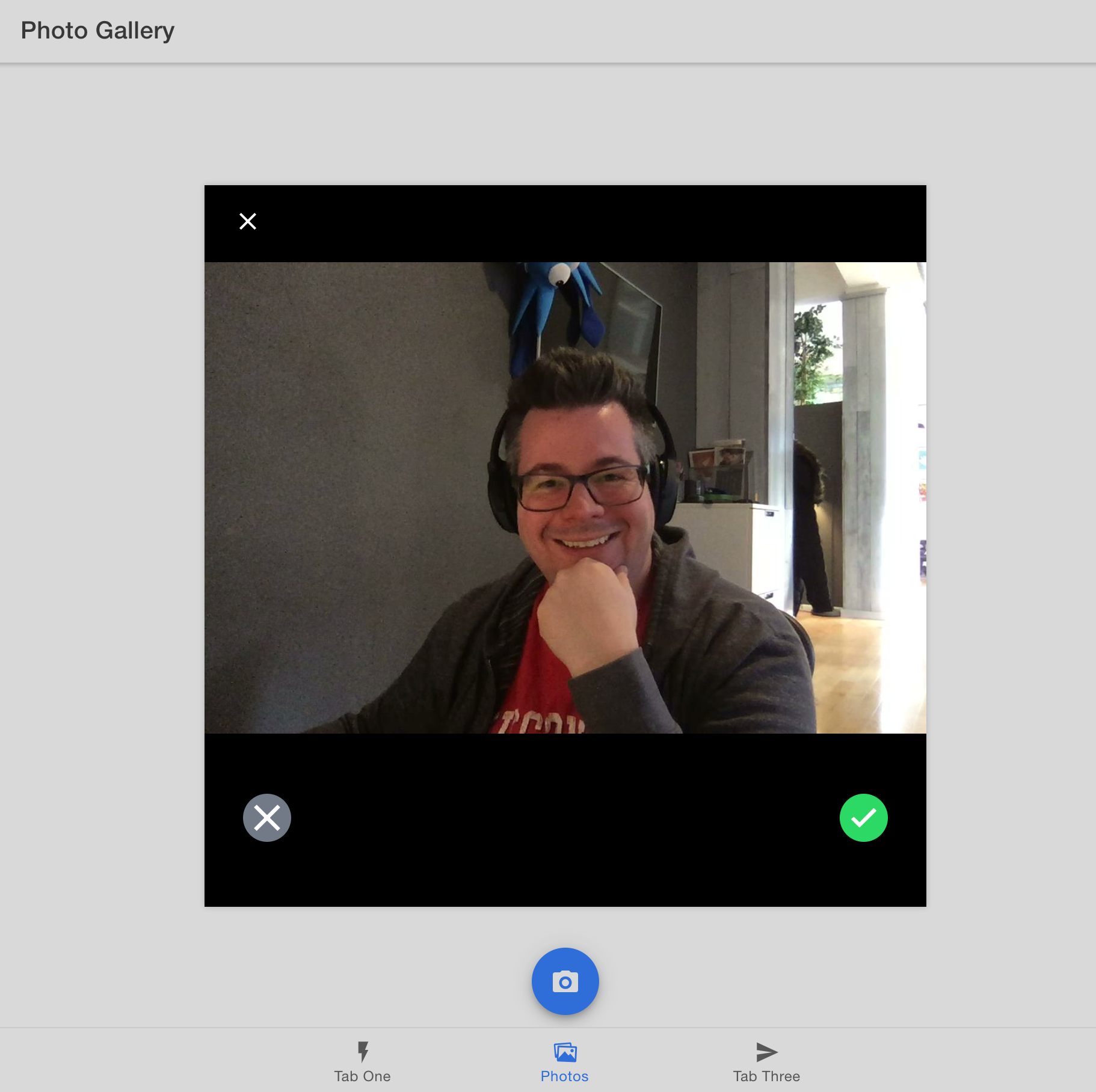Taking Photos with the Camera
Now for the fun part - adding the ability to take photos with the device’s camera using the Capacitor Camera API. We’ll begin with building it for the web, then make some small tweaks to make it work on mobile (iOS and Android).
Photo Service
All Capacitor logic (Camera usage and other native features) will be encapsulated in a service class. Create PhotoService using the ionic generate command:
ionic g service services/photo.service
Open the new services/photo.service.ts file, and let’s add the logic that will power the camera functionality. First, import Capacitor dependencies and get references to the Camera, Filesystem, and Storage plugins:
import { Injectable } from '@angular/core';
// CHANGE: Add the following import
import { Camera, CameraResultType, CameraSource } from '@capacitor/camera';
@Injectable({
providedIn: 'root',
})
export class PhotoService {}
Next, define a new class method, addNewToGallery(), that will contain the core logic to take a device photo and save it to the filesystem. Let’s start by opening the device camera.
import { Injectable } from '@angular/core';
import { Camera, CameraResultType, CameraSource } from '@capacitor/camera';
@Injectable({
providedIn: 'root',
})
export class PhotoService {
// CHANGE: Add the gallery method
public async addNewToGallery() {
// Take a photo
const capturedPhoto = await Camera.getPhoto({
resultType: CameraResultType.Uri,
source: CameraSource.Camera,
quality: 100,
});
}
}
Notice the magic here: there's no platform-specific code (web, iOS, or Android)! The Capacitor Camera plugin abstracts that away for us, leaving just one method call - Camera.getPhoto() - that will open up the device's camera and allow us to take photos.
Next, in tab2.page.ts, import the PhotoService class and add a method to call its addNewToGallery method.
import { Component } from '@angular/core';
// CHANGE: Import the PhotoService
import { PhotoService } from '../services/photo.service';
@Component({
selector: 'app-tab2',
templateUrl: 'tab2.page.html',
styleUrls: ['tab2.page.scss'],
standalone: false,
})
export class Tab2Page {
// CHANGE: Update constructor to include `photoService`
constructor(public photoService: PhotoService) {}
// CHANGE: Add `addNewToGallery()` method
addPhotoToGallery() {
this.photoService.addNewToGallery();
}
}
Then, open tab2.page.html and call the addPhotoToGallery() method when the FAB is tapped/clicked:
<ion-header [translucent]="true">
<ion-toolbar>
<ion-title> Photo Gallery </ion-title>
</ion-toolbar>
</ion-header>
<ion-content [fullscreen]="true">
<ion-header collapse="condense">
<ion-toolbar>
<ion-title size="large">Photo Gallery</ion-title>
</ion-toolbar>
</ion-header>
<ion-fab vertical="bottom" horizontal="center" slot="fixed">
<!-- CHANGE: Add a click event listener to the floating action button -->
<ion-fab-button (click)="addPhotoToGallery()">
<ion-icon name="camera"></ion-icon>
</ion-fab-button>
</ion-fab>
</ion-content>
If it's not running already, restart the development server in your browser by running ionic serve. On the Photo Gallery tab, click the Camera button. If your computer has a webcam of any sort, a modal window appears. Take a selfie!

(Your selfie is probably much better than mine)
After taking a photo, it disappears right away. We need to display it within our app and save it for future access.
Displaying Photos
To define the data structure for our photo metadata, create a new interface named UserPhoto. Add this interface at the very bottom of the photo.service.ts file, immediately after the PhotoService class definition:
export class PhotoService {
// ...existing code...
}
// CHANGE: Add the `UserPhoto` interface
export interface UserPhoto {
filepath: string;
webviewPath?: string;
}
Above the addNewToGallery() method, define an array of UserPhoto, which will contain a reference to each photo captured with the Camera.
export class PhotoService {
// CHANGE: Add the `photos` array
public photos: UserPhoto[] = [];
public async addNewToGallery() {
// ...existing code...
}
}
Over in the addNewToGallery method, add the newly captured photo to the beginning of the photos array.
// CHANGE: Update `addNewToGallery()` method
public async addNewToGallery() {
// Take a photo
const capturedPhoto = await Camera.getPhoto({
resultType: CameraResultType.Uri,
source: CameraSource.Camera,
quality: 100
});
// CHANGE: Add the new photo to the photos array
this.photos.unshift({
filepath: "soon...",
webviewPath: capturedPhoto.webPath!
});
}
photo.service.ts should now look like this:
import { Injectable } from '@angular/core';
import { Camera, CameraResultType, CameraSource } from '@capacitor/camera';
@Injectable({
providedIn: 'root',
})
export class PhotoService {
public photos: UserPhoto[] = [];
public async addNewToGallery() {
// Take a photo
const capturedPhoto = await Camera.getPhoto({
resultType: CameraResultType.Uri,
source: CameraSource.Camera,
quality: 100,
});
this.photos.unshift({
filepath: 'soon...',
webviewPath: capturedPhoto.webPath!,
});
}
}
export interface UserPhoto {
filepath: string;
webviewPath?: string;
}
Next, switch to tab2.page.html to display the images. We'll add a Grid component to ensure the photos display neatly as they're added to the gallery. Inside the grid, loop through each photo in the PhotoService's photos array. For each item, add an Image component and set its src property to the photo's path.
<ion-header [translucent]="true">
<ion-toolbar>
<ion-title> Photo Gallery </ion-title>
</ion-toolbar>
</ion-header>
<ion-content [fullscreen]="true">
<ion-header collapse="condense">
<ion-toolbar>
<ion-title size="large">Photo Gallery</ion-title>
</ion-toolbar>
</ion-header>
<!-- CHANGE: Add a grid component to display the photos. -->
<ion-grid>
<ion-row>
<!-- CHANGE: Create a new column and image component for each photo -->
<ion-col size="6" *ngFor="let photo of photoService.photos; index as position">
<ion-img [src]="photo.webviewPath"></ion-img>
</ion-col>
</ion-row>
</ion-grid>
<ion-fab vertical="bottom" horizontal="center" slot="fixed">
<ion-fab-button (click)="addPhotoToGallery()">
<ion-icon name="camera"></ion-icon>
</ion-fab-button>
</ion-fab>
</ion-content>
Within the web browser, click the camera button and take another photo. This time, the photo is displayed in the Photo Gallery!
Up next, we’ll add support for saving the photos to the filesystem, so they can be retrieved and displayed in our app at a later time.